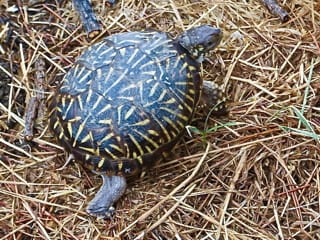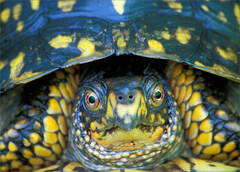

Supplement the diet with a weekly dusting of a phosphorus-free calcium powder such as RepCal or ground cuttlebone.Variety is the key to a healthy appetite and good health.Dark, leafy greens such as romaine, kale, collards, dandelion, mustard greens, and broccoli are preferred over iceberg lettuce.Are attracted to brightly colored fruits and vegetables: tomato, squash, carrots, red bell peppers, strawberries, cantaloupe.Ideally the protein should be whole live foods like earthworms, mealworms, beetles, grubs, crickets, slugs and snails. Captive box turtles may be fed a diet that is 50% mixed fresh vegetables with some fruit, and 50% low fat protein like canned low-fat dog food.Diet in the wild includes insects, grubs, worms, snails, slugs, crustaceans, eggs, carrion, mushrooms, flowers, fruit and other plant material. Females lay 3-5 eggs, which incubate 70-90 days before hatching.Female box turtles generally have brown eyes, a flat plastron, gently-curved rear toenails, and their vent lies near the base of the tail, within the caudal margin of the carapace.Male box turtles generally have bright red eyes, a slightly concave plastron (lower-shell), sharply-hooked rear toenails, and their vent lies closer to the end of the tail, beyond the caudal margin of the carapace (upper-shell).Western Ornate Box Turtle ( Terrapene ornata ornata).Three-toed Box Turtle ( Terrapene carolina triunguis).Gulf Coast Box Turtle ( Terrapene carolina major).Eastern Box Turtle ( Terrapene carolina carolina).Box turtles of the genus Terrapene species commonly seen as pets include:.Readers are strongly encouraged to seek more detailed information on the particular type of box turtle they own. What follows are very general guidelines. It is possible for you and your box turtle to have a long and happy relationship together if you provide a suitable environment and proper care. They often have distinctive personalities and learn to respond to their keepers. North American box turtles are hardy, long-lived reptiles that thrive in captivity when properly cared for.

Husbandry for Terrestrial Turtles & Tortoises.Chemotherapy For Ferrets With Insulinoma.Instead it cuts its food with the sharp edges of its jaws. As with all turtles the ornate box turtle has no teeth. Ornate box turtles are omnivorous, meaning that they eat both plants (fruit, flowers, and mushrooms) and animals (grasshoppers, beetles, earthworms, and caterpillars). Deadly enemies of box turtle eggs and hatchlings are raccoons and skunks. Between two and 50 eggs are laid in each clutch. The eggshell keeps the growing turtle from getting too dry. Turtles can move only their head, neck, legs, and tail.Īll turtles in Kansas lay their eggs on land, in sand or soft soil. A hinge arrangement allows the upper and lower shells to close firmly together for defense against predators. The shell of a turtle is made of the carapace (upper shell) and the plastron (lower shell). Examples of reptiles are lizards, snakes, and alligators. Young reptiles are miniature versions of their parents and do not need to go through metamorphosis stages to reach adulthood as do amphibians. They are cold-blooded animals they reproduce by laying eggs out of the water, and they have scales on their body that allow them to live away from the moist areas where amphibians are confined. Males are smaller and have red eyes while females are larger and usually have yellow-brown eyes. The yellow stripes on both the upper shell and lower shell of the ornate box turtle identify this species. The ornate box turtle is also a dryland turtle, which means that it spends its life on land and not in the water.ĭuring the 30 to 50 years of its life it spends a large amount of time crawling through fields, across backyards, and in the woods. It is the most visibly abundant turtle in Kansas. The ornate box turtle is found in the prairies of western Kansas to the forests of eastern Kansas. On April 14, 1986, their lobbying campaign ended with Governor John Carlin signing the bill. In observance of the 125th anniversary of Kansas statehood, a sixth-grade class in Caldwell decided to nominate the ornate box turtle as the state reptile.


 0 kommentar(er)
0 kommentar(er)
